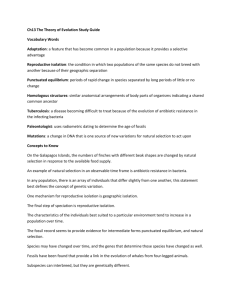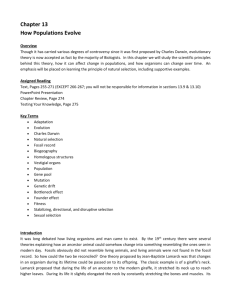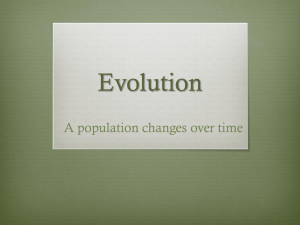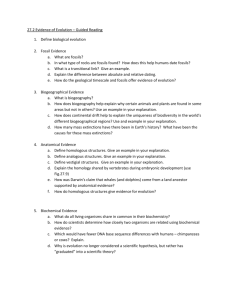Evidence of Evolution Chapter 11
advertisement
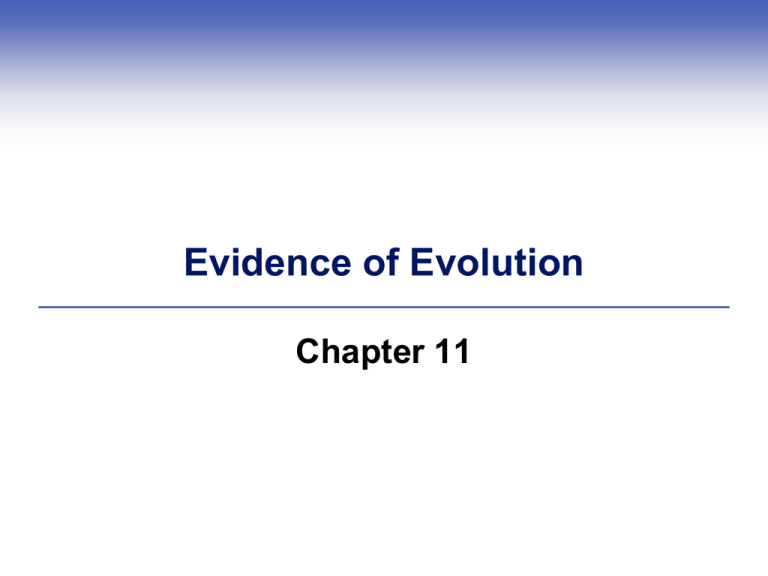
Evidence of Evolution Chapter 11 11.1 Impacts/Issues Reflections of a Distant Past Events of the ancient past can be explained by the same physical, chemical, and biological processes that operate in today’s world From Evidence to Inference Scientists infer from evidence that an asteroid impact near the Yucatán 65 million years ago caused the mass extinction of dinosaurs Mass extinction • Simultaneous loss of many lineages from Earth From Evidence to Inference Barringer crater, Arizona Pioneers of Biogeography Late 1800s: Charles Darwin, Alfred Wallace and other naturalists observed patterns in where species live, how they might be related, and how natural forces might shape life Biogeography • Study of patterns in the geographic distribution of species and communities Biogeography Wallace and Darwin thought similarities in birds on different continents might indicate a common ancestor Biogeography Some plants that lived in similar climates on different continents had similar features, but were not closely related Comparative Morphology Naturalists studying body plans were confused by vestigial body parts with no apparent function Comparative morphology • Scientific study of body plans and structures among groups of organisms Vestigial Body Parts Geology Identical rock layers in different parts of the world, sequences of similar fossils, and fossils of giant animals with no living representatives also puzzled early naturalists Confusing Discoveries Taken as a whole, findings from biogeography, comparative morphology, and geology did not fit with prevailing beliefs of the 19th century Increasingly extensive observations of nature led to new ways of thinking about the natural world Comparative pelvic anatomy 11.3 A Flurry of New Theories Nineteenth-century naturalists tried to explain the accumulating evidence of evolution Georges Cuvier proposed that catastrophic geologic forces unlike those of the present day shaped Earth’s surface (catastrophism) Jean-Baptiste Lamarck proposed that changes in an animal over its lifetime were inherited Evolution Naturalists suspected that environmental factors affected affect a species’ traits over time, causing changes in a line of descent Evolution • Change in a line of descent (in a line from an ancestor) Voyage of the Beagle 1831: Charles Darwin set out as a naturalist on a five-year voyage aboard the Beagle He found many unusual fossils and observed animals living in many different environments Darwin and the Voyage of the Beagle Lyell’s Theory of Uniformity Darwin was influenced by Charles Lyell’s Principles of Geology, which set forth the theory of uniformity – in contrast to catastrophism Theory of uniformity • Idea that gradual repetitive processes occurring over long time spans shaped Earth’s surface Shared Traits Darwin collected fossils of extinct glyptodons, which shared traits with modern armadillos Limited Resources Thomas Malthus observed that: • A population tends to grow until it begins to exhaust environmental resources—food, shelter from predators, etc • When resources become scarce, individuals must compete for them Darwin applied these ideas to the species he had observed on his voyage Fitness Darwin realized that in any population, some individuals have traits that make them better suited to the environment than others, and therefore more likely to survive and reproduce Fitness • The degree of adaptation to an environment, as measured by an individual’s relative genetic contribution to future generations Adaptation Adaptive traits that impart greater fitness to an individual become more common in a population over generations, compared with less competitive forms Adaptation (adaptive trait) • A heritable trait that enhances an individual’s fitness Natural Selection Darwin concluded that the process of natural selection, through variations in fitness and adaptation, is a driving force of evolution Natural selection • Differential survival and reproduction of individuals of a population that vary in the details of shared, heritable traits Great Minds Think Alike Alfred Wallace, the “father of biogeography”, proposed the theory of natural selection in 1858, at the same time as Darwin Darwin published On the Origin of Species the following year, in which he described descent with modification, or evolution Alfred Wallace The codiscoverer of natural selection Principles of Natural Selection The Galapagos Islands 11.4 About Fossils Fossils • Physical evidence of organisms from the past • Hard fossils include mineralized bones, teeth, shells, spores and other hard body parts • Trace fossils include footprints, nests, trails, feces and other evidence of activities A A 30-million-year-old fossil of Elomeryx. This small terrestrial mammal was a member of the same artiodactyl group that gave rise to hippopotamuses, pigs, deer, sheep, cows, and whales. Fig. 11-7a, p. 202 B Rodhocetus, an ancient whale, lived about 47 million years ago. Its distinctive ankle bones point to a close evolutionary connection to artiodactyls. Inset: compare a Rodhocetus ankle bone (left) with that of a modern artiodactyl, a pronghorn antelope (right). Fig. 11-7b, p. 202 C Dorudonatrox, an ancient whale that lived about 37 million years ago. Its artiodactyl-like ankle bones (left) were much too small to have supported the weight of its huge body on land, so this mammal had to be fully aquatic. Fig. 11-7c, p. 202 11.5 Putting Time Into Perspective Transitions in the fossil record, found in characteristic layers of sedimentary rock, became boundaries for great intervals of the geologic time scale Geologic time scale • Chronology of Earth history • Correlates with evolutionary events Drifting Continents, Changing Seas Theory of continental drift • Earth’s continents were once part of a single supercontinent that split up and drifted apart • Explains how the same types of fossils can occur on both sides of an ocean Pangea • Supercontinent that formed about 237 million years ago and broke up about 152 million year ago Plate Tectonics: A Mechanism of Continental Drift Theory of plate tectonics • Earth’s outer layer of rock is cracked into plates • Slow movement rafts continents to new positions over geologic time • Where plates spread apart, molten rock wells up from deep inside the Earth and solidifies • Where plates collide, one slides under the other and is destroyed Plate Tectonics Gondwana Certain fossils of ferns and reptiles that predate Pangea are found in similar rock layers in Africa, India, South America, and Australia – evidence of an even earlier supercontinent Gondwana • Supercontinent that formed more than 500 million years ago Impacts on Evolution Evidence suggests that supercontinents have formed and broken up at least five times The resulting changes in the Earth’s surface, atmosphere, waters and climates have had profound impacts on evolution 11.6 Similarities in Body Form and Function Similarities in structure of body parts are often evidence of a common ancestor Homologous structures • Similar body parts that reflect shared ancestry • May be used for different purposes in different groups, but the same genes direct their development Morphological Divergence A body part that appears very different in appearance may be quite similar in underlying aspects of form – evidence of shared ancestry Morphological divergence • Evolutionary pattern in which a body part of an ancestor changes in its descendants (homologous structures) Morphological Divergence Among Vertebrate Forelimbs pterosaur chicken penguin stem reptile porpoise bat human elephant Fig. 11-12, p. 208 Morphological Convergence Some body parts look alike in different lineages, but did not evolve in a common ancestor Analogous structures • Similar structures that evolved separately in different lineages Morphological convergence • Evolutionary pattern in which similar body parts evolve separately in different lineage Morphological Convergence Insects Bats Humans Crocodiles wings Birds wings wings limbs with 5 digits Fig. 11-13d, p. 209 Comparative Embryology Embryos of related species tend to develop in similar ways Similarities in patterns of embryonic development are the result of master genes (homeotic genes) that have been conserved over evolutionary time Comparative Embryology Fig. 11-14a, p. 210 Fig. 11-14b, p. 210 Fig. 11-14c, p. 210 Fig. 11-14d, p. 210 Fig. 11-14e, p. 210 11.7 Biochemical Similarities Each lineage has unique characters that are a mixture of ancestral and novel traits, including biochemical features such as the nucleotide sequence of DNA We can discover and clarify evolutionary relationships through comparisons of nucleic acid and protein sequences


